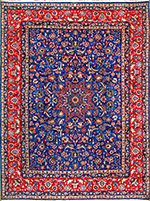Textiles Studies

Textile Research Works
Date of this Version
1993
Document Type
Article
Citation
In Official Cult and Popular Religion in the Ancient Near East. Papers of the First Colloquium on the Ancient Near East - The City and its Life held at the Middle Eastern Culture Center in Japan (Mitaka, Tokyo) March 20-22, 1992. Edited by EIKO MATSUSHIMA, THE MIDDLE EASTERN CULTURE CENTER IN JAPAN
Abstract
Sasanian art has long been considered a royal art: An art in service of royalty. Indeed, traditions of kingship in Iran became a paradigm for kingship throughout the world (though not always recognized as such). But the significance and strength of Iranian kingship no doubt led, in part, to scholarly paradigms in which nearly all in historical Iran has been cast in the shadow of kingship. But there are other ways to look at kingship in Iran. This paper explores the representation of royal images in early Sasanian art from a religious perspective, a view perhaps eclipsed by the ever-present focus on royalty. Discussion rests primarily on the analysis of visual sources pertaining to Ardashir 1. Key to the arguments presented are the monumental rock reliefs commissioned most likely during his reign , and coins of his issue. Also relevant to the discussion are royal images pertaining to Ardashir's immediate successors. Among the most famous of early Sasanian reliefs is the Triumph of Shapur J at Naqsh-i Rustam. A Roman emperor is seen kneeling before the mounted Shapur. This image is striking for the directness of its imagery, depicting one monarch bowing before another, thus, immediately defining a non-Roman context: For where in the Western world would we see a Roman emperor kneeling before a foreign monarch? This perspective immediately defines us as outsiders, and provides us an opportunity to view the world of Iran from the inside rather than from the outside looking in. We may thus look into the mind of a tradition removed -- one at times antithetical to our own. Our point of reference is external, our point of view from the West. Critical viewing of Persian royal imagery provides an exceptional opportunity for us as outsiders to enjoy a view from the inside. For in looking at art, we may see what the Persians saw, and even understand some of what they understood if we look closely and carefully. There is something to these royal images, something beyond their pomp, that enables us to see what is culturally relevant and meaningful to the contemporary viewing audience of the third century. Art offers the possibility of an insider's view without the necessity of an intermediary literal translation: we may see what the ancients saw. This transcendental aspect of art is due, in part, to its force as a visual medium.
Included in
Art and Materials Conservation Commons, Art Practice Commons, Fiber, Textile, and Weaving Arts Commons, Indigenous Studies Commons, Museum Studies Commons


Comments
Copyright © 1993 UNIVERSITATSVERLAG C. WINTER HEIDELBERG